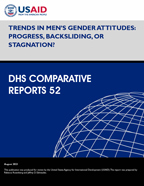There is no printed copy available to order.
Abstract:
A growing literature has shown that social norms influence a wide range of social, health, and demographic outcomes and behaviors. Gender norms, the informal and generally unwritten rules about what is considered to be appropriate masculine or feminine behaviors and the relative roles of men and women in society, are especially important in shaping decisions and behavior within heterosexual relationships. Most commonly, these norms establish unequal power in relationships in ways that favor men over women. This means that women’s behavior is often strongly influenced by men’s attitudes and preferences. As a result, better understanding of men’s gendered attitudes is important because these attitudes influence not only the men’s behavior but their partners. However, comparatively little attention has been paid to understanding men’s gendered attitudes, how these have changed over time, or how these compare to those of women. This comparative study helps to address this gap by using DHS data from 26 countries to examine levels and trends of men’s attitudes, preferences, and behaviors across five areas: ? Justification for intimate partner violence ? Women’s involvement in household decisions ? Women’s sexual autonomy ? Women’s contraceptive use ? Son preference We first examine the trends over time in each area for men by using data from three DHS surveys collected in each country since 2000. Based on how unequal the views of men were in the first survey and subsequent changes, we then selected six countries for further examination of how men and women’s attitudes compared for each area (the exception being women’s contraceptive use because comparable questions were not asked for both men and women. The results show that there has been a general decline in men’s inequitable gender attitudes, preferences, and behaviors in the countries included in the study. However, this decline has not been consistent across the five areas, and very significant proportions of men continue to report inequitable gender attitudes. Across the indicators, the greatest levels of change took place in those areas where the levels of unequal views, preferences, or behaviors were highest at the beginning of the period we examined. The largest changes were seen in women’s involvement in household decisions (specifically about major household purchases), the justification of intimate partner violence, and women’s sexual autonomy. In contrast, there was less change in attitudes toward women’s contraceptive use and son preference. These results suggest that there have been widespread improvements in men’s gender attitudes, although there is considerable room for further improvement. In the comparison of men’s and women’s trends, the results showed that in general, men’s gender attitudes, preferences, and behaviors are significantly less egalitarian than women’s. The exceptions were the justification of intimate partner violence and the women’s sexual autonomy measures, which relied on a subset of the questions on justification of violence where women’s attitudes were significantly more unequal than men’s. There was limited evidence that men’s and women’s gender attitudes were converging over time, although these usually changed in the same direction and at the same pace. These results suggest that the improvements in gender norms may be the result of broader changes that influence men and women in the same way. The results have implications for policy, programming, and research. For policy and programming, the patterns suggest that rapid, large changes in gender attitudes and norms are possible across a wide range of countries and settings. However, very large proportions of both men and women continue to hold unequal views that hinder this process of positive change. Developing policy and programming that is targeted specifically toward men is also important, because men continue to have higher levels of unequal views than women in almost all scenarios. One important area is men’s perceptions of reproduction and contraceptive use as primarily a woman’s concern that is not their responsibility. Programmers and policymakers should also focus more attention on understanding and addressing the high levels of support expressed by women to justify intimate partner violence. In terms of research and measurement, this study highlights the paucity of adequate measures of gender attitudes and norms available in the DHS and similar surveys. Incorporating better measures would be an important step toward more comprehensive research on gender norms and their impact on health and other outcomes. Finally, the results highlight the need for more research that examines how and why men’s and women’s reports differ from each other, both at the level of couples and more broadly.
 Trends in Men’s Gender Attitudes: Progress, Backsliding, or Stagnation? (PDF, 902K)
Trends in Men’s Gender Attitudes: Progress, Backsliding, or Stagnation? (PDF, 902K)
 Trends in Men’s Gender Attitudes: Progress, Backsliding,or Stagnation? (CR52) - Analysis Brief
Trends in Men’s Gender Attitudes: Progress, Backsliding,or Stagnation? (CR52) - Analysis Brief
